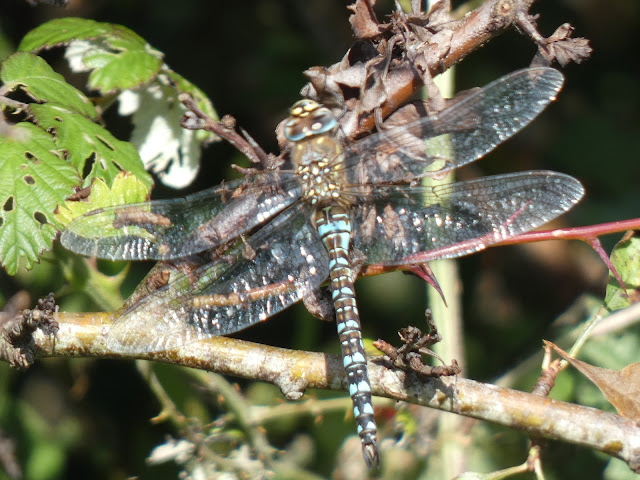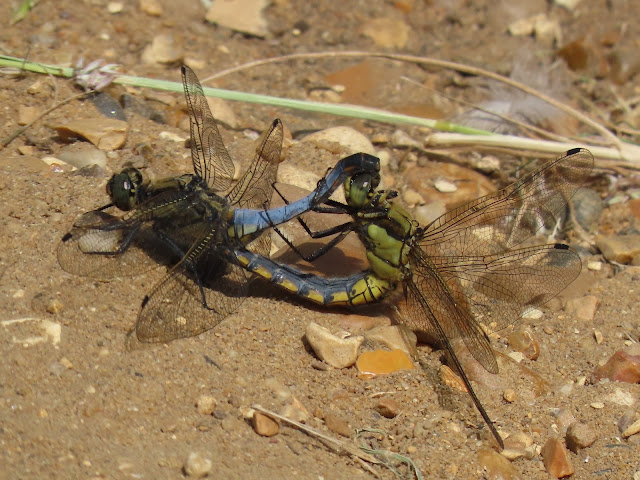Having missed our annual winter trip to Norfolk at the beginning of the
year due to lockdown, we decided to reschedule it to November. I met John &
Janet at Kings Cross station on Tuesday morning, November 2nd and we took the 10.52 train up
to Kings Lynn. It was a lovely calm sunny day as we headed deep into East
Anglia but there wasn't too much to be seen on the way up other than fields full
of large numbers of Lapwings, Woodpigeons and Starlings. We did saw a few
Buzzards and Kestrels but there was no sign of any wild swans as we passed
through the fens.
At Kings Lynn we transferred to the local bus which weaved its way through
villages up to Hunstanton. We did manage to see a flock of Pink-feet flying
over the fields and I'm pretty sure there was a white bird in amongst them but
wouldn't go so far as claiming it as a Snow or Ross's Goose.
We checked into our hotel then had plenty of time to go for a walk along
the promenade. We scanned the Wash from one of the raised lookouts and John
located a close diver. We expected it to be a Red-throated but surprisingly it
turned out to be a Black-throat in full summer plumage, a really smart bird. We
found a few Red-throats as well then wandered up towards the cliffs seeing a
few Turnstones and Oystercatchers. The tide was high so it wasn't great for
waders. It should have been better for seaducks but we didn't see a single one.
 |
| Red-throated Diver |
 |
| Hunstanton cliffs |
We wandered up to the cliffs then back south towards Heacham adding a few
Sanderling to the wader list. It was glorious sunny afternoon and the number of
holidaymakers also on the promenade made it very different to our normal winter
visits. We stopped in a beachside cafe for hot drinks then wound our way back
to the hotel.
 |
| Sanderling |
 |
| Turnstone |
For dinner we chose The Mariner, a pub we'd not visited before but the bar
menu looked good. And so it proved, along with a nice pint of Doombar to wash
it down.
Wednesday 3rd
With the change back to GMT last weekend we had plenty of daylight before
breakfast to do some more seafront birding. As we met outside the hotel at 6.45
it was obvious there was visible migration going on as Redwings 'seeped' over.
We headed for the viewpoint and set up scopes. Within a few minutes several
more large Redwing flocks flew west over The Wash followed by an enormous flock
of 2,000 Starling coasting, although here it meant them travelling south. It
was a precursor to spectacular day of Starling movement with the passage
continuing all day. A flock of Pink-feet flew out of The Wash followed a bit later by a small flock of Brents.
Out to sea a couple of Red-throated Divers flew in, landed on the sea,
dived and never resurfaced, a fairly typical diver trick. A lone distant
Greylag Goose tried to pass itself off as something more interesting while a
couple of drake Eider flew north, the only seaduck of the day.
We returned to the hotel for breakfast then headed down to the bus station
for the bus to Titchwell. Before heading down the entrance track we could see
waders feeding in one of the fields, there was a flock of Black-tailed Godwits
as well as some Ruff while on the other side a Red Kite flew over.
We headed into the reserve and started off walking around the woods. A few
Redwings were in the trees along with some Song Thrushes and Blackbirds that
had likely arrived with them. However there was no sign of any of the
Fieldfares that had been seen earlier.
Taking our time we walked along the main track scanning both sides. A
little group of Bearded Tits flew across and a Marsh Harrier hunted over the
marshes. The first lagoon was heaving with waders and wildfowl and we slowly
went through all of them. Brent Geese chattered away as they flew over in small
groups.
 |
| Brent Geese |
 |
| Teal |
By the time we reached the beach it was low tide and it had started to
drizzle. Nevertheless we gave it a bit of time although there wasn't much to be
seen. A flock of eight Eider flew West and Starling flocks caught the eye as
they passed over low over the sea. With the precipitation now turning to rain
we headed back to the main hide for some shelter and a lunch break. Even here
Starling flocks continued to fly past.
 |
| Dunlin |
We continued back along the path and went through the woods again, adding a
few Goldcrests in a mixed tit flock. We stopped at the cafe for hot drinks and
to get out of the rain for a bit. The showers had become heavier and more
frequent so we decided not to head back into the reserve and instead headed for
the bus stop to give us time to scan the fields for owls and raptors.
Unfortunately this meant we missed a group of three Glossy Ibis that flew west
over the main track! We didn't see any owls but did get four Common Buzzards
and still more flocks of Starlings heading west.
Once back at Hunstanton we had a short walk along the promenade but didn't
see anything so headed back to the hotel for a rest before going out to Chives
for dinner.
Thursday 4th
Overnight the wind had picked up and there had been some rain but it was
clear at dawn so I headed towards the lookout hearing two Brambling en route.
As I walked through the little park a squall hit so I veered over to the
covered seating area instead. This also gave protection from the strong
northwesterly so I stayed here, being shortly joined by John. Redwings and
Starlings were moving through and there was plenty of action on the sea.
Single Guillemot and Razorbill were seen but not the hoped for Little Auk.
Gannet, Red-breasted Merganser and Common Scoter were added, the latter being
also being a year tick. Two late Arctic Terns flew past and then I picked up a
distant Sooty Shearwater also flying north out of The Wash. As we headed back
for breakfast more Starlings headed over making a total of 3,300 in an hour.
We took the same bus as yesterday but further along the coast to Holkham. Wandering
slowly down Lady Anne’s Drive paid dividends as we came across a close covey of
Grey Partridges which also included a single Red-legged. The marshes also
hosted plenty of Wigeon and Teal and a few Curlew.
 |
| Curlew |
 |
| Grey Partridge |
 |
| Red-legged Partridge |
 |
| Wigeon |
The main target here was
Shore Lark so we headed straight onto the beach to the roped-off area. A few
returning birders confirmed there were two birds showing so we went straight to
the far end and had good scope views of both birds.
 |
| Shore Lark |
We decided to continue over to the dunes for a scan of the sea. By now the
NW wind was really strong so we had to use the edge of the dunes for shelter. A
couple of groups of Eider flew west and we picked up four more Sooty
Shearwaters flying east. We were hoping for Little Auk as they had been seen
further along the coast but we didn’t manage to connect with any. There were a
few waders on the beach and I also saw an adult Med Gull which promptly
disappeared.
We needed to escape from the wind so headed back, pausing to take another
look at the Shore Larks. They were a bit closer from this side and we found
four this time. Back at the centre we decided to stop at the cafe for lunch and
a much needed hot drink. The plan for the rest of the afternoon was to walk
through the woods where we could be guaranteed some shelter from the wind.
The woods were very quiet and we only came across one tit flock which also
had a Treecreeper in it but no Yellow-brows which we’d been hoping for. We
stopped in the hides along the way, seeing four Great Egrets, a White-fronted
Goose and the usual raptor fest of Red Kites, Marsh Harriers and Common
Buzzards. A few groups of Pink-feet flew past and I haven’t mentioned the
Starlings yet which were migrating westwards in flocks all day long so they
were difficult to count.
With the afternoon light beginning to fade we walked slowly back to the
centre and stopped to scan for a while, hoping to pick up a Barn Owl but none
were seen. With Starling flocks continuing to zip over we headed back to the
bus stop. It was dark by the time we left so we couldn’t see anything else
along the way back. Tonight’s dinner was taken in a fish and chip restaurant
which was accompanied by a bottle of Ghost Ship.
Friday 5th
Our last morning’s birding was spent on the lookout at the beach as the
wind had abated somewhat and there was no rain. There were some large flocks of
Knot heading into The Wash with about 600 in total; as we watched them shimmer
over the waves they were briefly joined by another huge wave of Starlings out
at sea. Starling numbers were even higher than previous day and we counted over
17,000 in less than 50 minutes. We also had our first Fieldfares of autumn
while out at sea there were a few Common Scoter and Red-throated Divers.
All too soon we had back to the hotel for breakfast and to pack up. Once we’d
settled up we headed down to the bus station and got an early bus back down to
Kings Lynn. There were more Pinkies in the fields along the way. We arrived in
plenty of time for the 10.44 train to London. Our group trip list was added up
and reached a respectable 104 species. It was had to choose a bird of the trip
but the impressive migration of Starlings was a top contender; we counted 28,580
but this must have been a fraction of the birds that actually flew over during
our stay.











































































